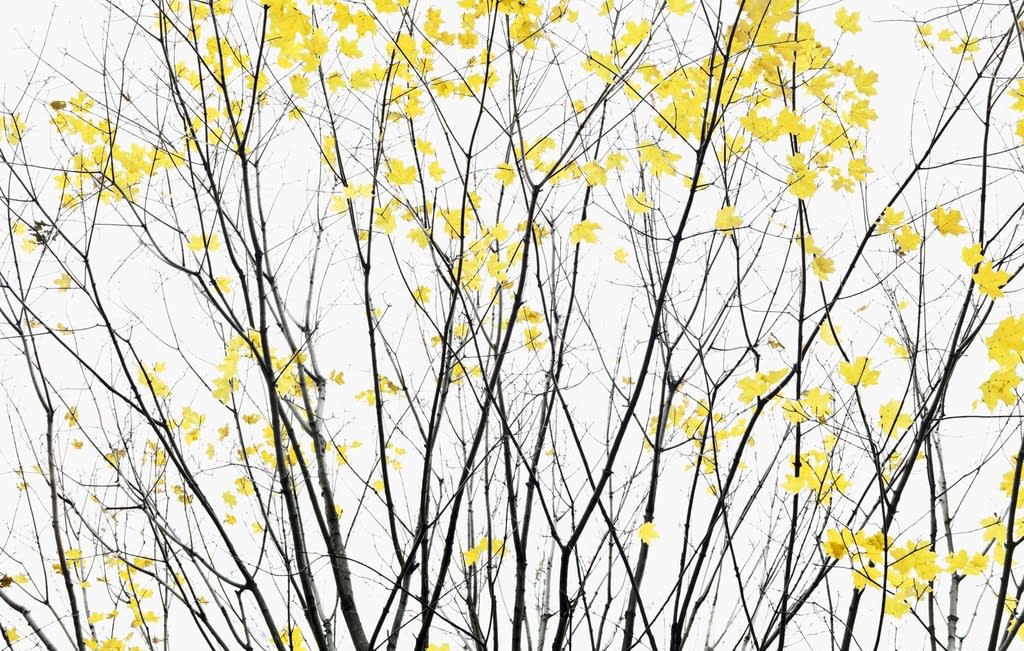
There is an attraction all of us have to trees. For photographers, trees hold a special fascination. For 170 years, photographers have used trees as subject matter. The broad variety of species of trees, the visual entertainment of how the trunk and branches expand, turn and twist make each tree different. Leaf sizes, shapes and colors add to the visual diversity. Combining the magic of nature with the time of day and the light of each changing season illuminate each tree and forest with wonderment. The branches, with or without leaves, in life or in death, give the photographer any number of permutations with which to create an image.
Three contemporary photographers extensively include trees as the subject and focus of their images: David Reinfeld, Laurie Lambrecht and Vladimir Frumin. Each of their presentations of tree images is very different. Reinfeld captures the colors we imagine we see at sunrise, bright daylight, night fall in each season: summer, fall, winter, and spring – all of which are different. Lambrecht’s work is traditional, and reflects her own special vision of nature; trees, leaves and light. Frumin conveys a sense of film-noir, a mood of darkness and challenge, in his black and white film images.
With so many photographers taking photographs of trees, what makes any one image feel special? Each photographer brings their own “eye” to the creation of an image, regardless of how casual or studied the composition. In the Foreword, “Out on a Limb”, written by David Friend, to photographer James Balog’s book “Tree: A New Vision of the American Forest”, he wrote “…an individual tree often gets lost in the proverbial woods. No wonder, either that the elements that comprise a tree’s visual splendor—its dizzying proportions, its reassuring stasis , its branches expressing the duality of chaos and order – typically escapes the attention of a race of puny, scurrying, way-too-civilized Homo sapiens.” The photographer’s composition dictates whether we notice. (1)
Each image is unique. Yet, an image, while unique, may not standout as much as others. What makes an image special to a broad audience? How does the composition bring us back constantly to look at an image again and again. “Great trees are sculpturally elegant. They are grounded. They transcend time. They are humbling. They are authentic. They are nature’s ultimate survivors, having escaped the ravages of weather, fire, disease, insects and humans.” (2) Trees are a constant source of temptation and inspiration for photographers to seek that unique image that will standout.
Another consideration is the image as a physical object. Transition of the image into an object such as a silver gelatin, digital, platinum palladium print or sculpture, or any number of other ways a photographic image can be seen, held or exhibited, may make that image command a viewer’s attention.
There are images made with just the tree as the focus in the composition. Yet, it isn’t always just about the tree(s). Many images include people, animals, buildings and visual elements. It is a question whether these other elements distract our attention from a tree, or enhance our focus. The tree may become a stage or prominent backdrop to a portrait or group picture. Regardless, the tree has a special place compositionally in making the image. With Reinfeld, Lambrecht and Frumin, these images are all about trees.
In 2011, the Getty Museum created an exhibition of tree images taken entirely from its permanent collection. The exhibition, “In Focus: The Tree” and the related exhibition book “The Tree in Photographs”, was co-curated by Anne Lyden (then associate curator, Department of Photographs at the Getty Museum) and Françoise Reynaud (the Senior Curator of Photographs at the Musée Carnavalet in Paris). The text is an exceptional compilation of images showing trees in photographs from approximately 1840 to 2009. Describing trees in photography, Reynaud wrote: “The images had to be expressions of beauty, strength, fragility, grace, grandeur, strangeness, utility, and so on. The relationship between the individual tree and the scene or the event depicted is what’s interesting to see and to understand. Each photo tells a unique story.” (3)
Early on, a photographer approached the creation of an image thinking about it in black and white. Later, the photographer had the choice to capture the image in color. As image capture technology develops and post-processing tools expand, photographers have an even greater number of choices for the creation of an image. As artists, photographers are also influenced by the art movements of the time. These three photographers, Reinfeld, Lambrecht and Frumin, absorb all of this history, and then embed their own artistic style into their images, each very differently.
David Reinfeld’s photography is balanced between a study of both art, science and post processing. His early work is traditional with attention to composition and little if any post-processing. In “Canyon 1” we see a lone tree, mostly branchless, against the stark white stone of a mountain looking up to a blue sky. He takes advantage of the massive landscape, barren of trees to highlight the one lone tree in the image. The tree by itself might not be deserving of a solo image. However, set at the base of a large whitish stone expanse, it is put into context and conversation with the surroundings. Questions arise: Why is that tree all alone and singular in the image? Why is it bent over with only a tuft of unpleasant lean looking green pine-like needles at the top of the branch? Why are there so few branches? There are trees along the upper ridge. Why are these trees there and not where this lone tree has grown in isolation? The ridge trees, while distant from one another, are fuller and healthier looking. We empathize with this lone barely alive tree. There is a sense of heat in the air, and the sun must be high in the sky as we see a small, dark shadow of its meager branches against the base of the trunk. But its isolation on this rocky mountainside makes it feel special.
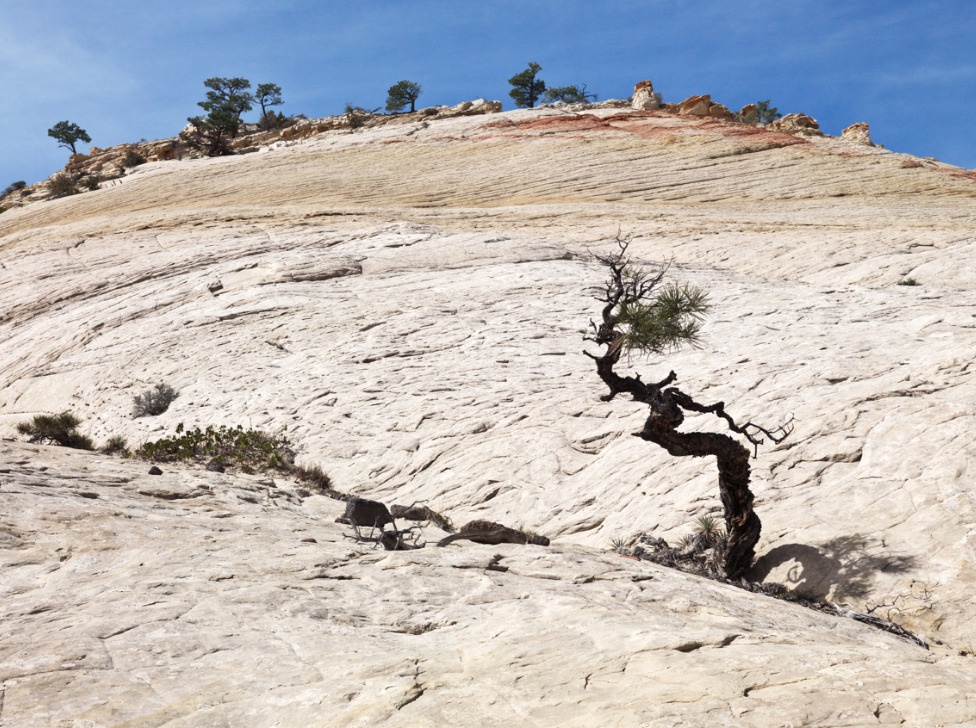
Compare this image to another of Reinfeld’s trees taken five years later. In the image “Forest 2”, the tree is barkless and weathered white. The trunk and branches are leafless, devoid of life. Yet, it stands prominent and proudly against a backdrop of green leaves on other trees and bushes. Like “Canyon 1”, this tree is alone, but on a very different setting of loneliness. Like “Canyon 1” it is lifeless, and even more leafless than the other. In contrast, the tree in “Forest 2” while dead-looking wood, is full of motion with the wild movements of its branches. How did this tree, that must have been so alive, die? And why is it surrounded by many trees that seem very alive?
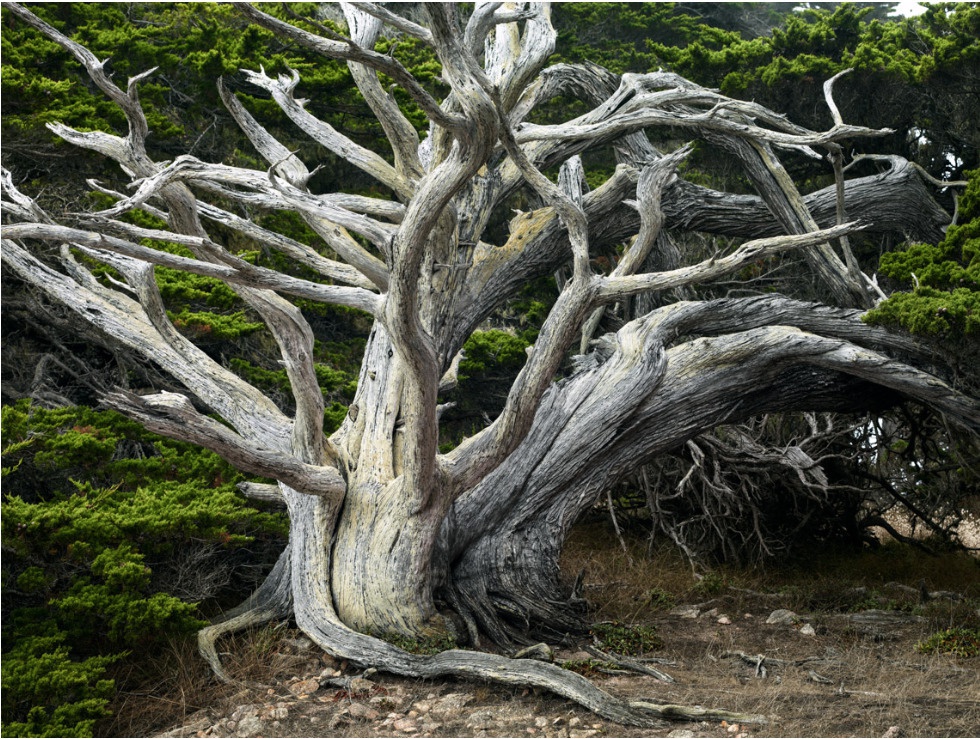
Four years later, in 2016, Reinfeld tries something different again. In the image “Brick & Mortar 1”, he experiments with a combination of two images. The lone tree in this image holds the color of fall. It is full of leaves that are turning yellow and red. Here, he has chosen to overlay an image of bricks. There is balance between man and nature. What Reinfeld illustrates is the pressure of man’s encroachment on nature and the devastating effect on trees as they adapt. Trees and all of nature are vulnerable.

We are all familiar with the term concrete jungle. These images remind us that for many people their only exposure to trees is in a local park. They may have never walked in a forest. Yet, as he was visiting the Southern United States, Reinfeld felt a different motivation. “When I photographed in Mississippi for the first time, I was struck by the juxtaposition of overlapping cultures and landscapes. The South felt divided to me; when I say divided, I’m not referring to the black and white political and social history. It’s the tension of comfort and cushiness glossing over the decay and strife. … Manicured bushes and well-cared for flowers planted in front of buildings in decline, stand out as a reminder of a divided culture. Then when I returned to New York, I saw the same thing. New York is a hodgepodge of wealth alongside poverty. It seemed every city I visited had this same feeling of division.”
Reinfeld’s earlier arboreal work was traditional, literal and thoughtful. However, how he “sees” was sourced very differently. Layered into his way of “seeing” is a condition that physically affects what he sees – binocular diplopia – or double vision. Early on in life, he thought everyone viewed the world the way he did. Later, he learned that this was not true. His eyes see colors and objects in groupings. Our mind reassembles what we believe we see into an object we recognize as trees and leaves. Through his vibrant images, Reinfeld shares what he sees.
It is against this setting that Reinfeld takes us to his most recent work -“Feynman’s Notes”. Originally a physicist, Reinfeld appreciates the work of Noble prize-awarded Richard P. Feynman, a theoretical physicist. Feynman’s work in physics influenced Reinfeld’s understanding of light as he was experiencing it. Reinfeld takes the viewer into a journey to appreciate light at various times of the day and seasons. “In Feynman’s Notes, I wanted the colors in part not to be naturally occurring, but to feel as if they should be. The colors are very much a response to what I see when I open my eyes to a brilliant sun. I see multitudes of colors swirling as my eyes adjust to the overpowering light. … Composition affects how light will radiate throughout the image, which in turn creates the feeling of color as the sun streams through the branches and leaves. The colors are similar to how light is refracted through a prism. Metaphorically, the trunks, branches, and leaves refract the light into multitudes of color.”
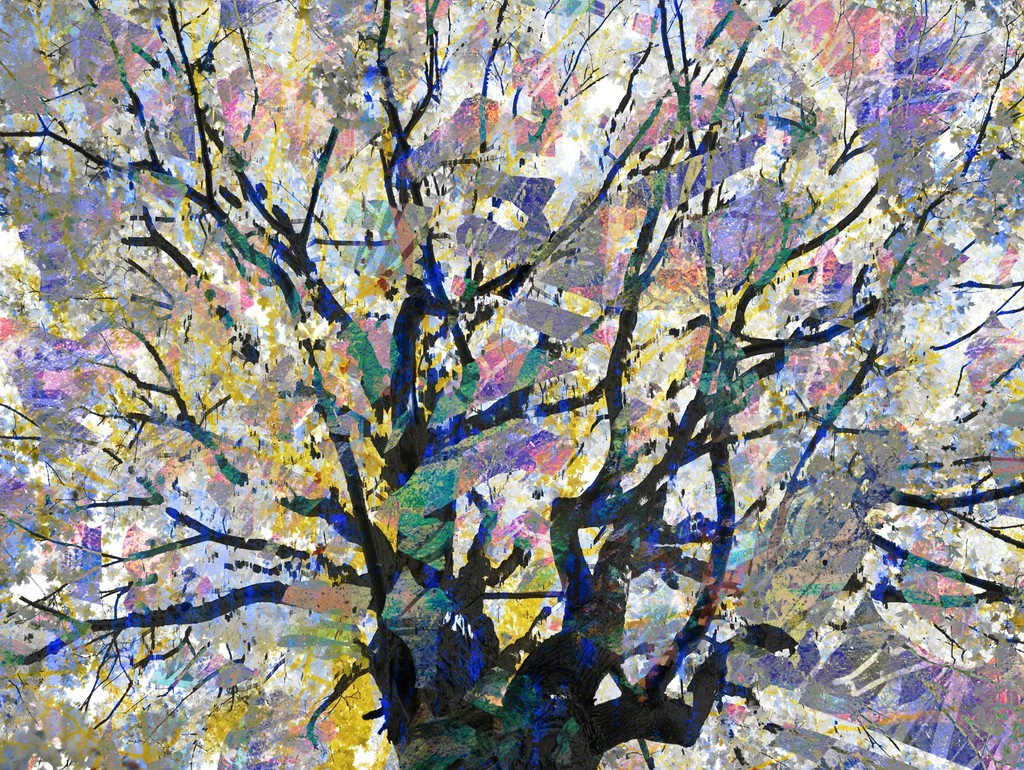 Image by David Reinfeld © 2018 “Feynman’s Notes 1”
Image by David Reinfeld © 2018 “Feynman’s Notes 1”
These works also reflect Reinfeld’s appreciation for painting. “I have thought about the differences between photography and painting for a long time. I realized that photography focuses upon a moment frozen in time, whereas painting is more about moments frozen over time. This is an important part of my photography. … Looking at Monet’s paintings made me realize time could be compressed as a composite of how we see over time. Wolf Kahn paints similarly. His use of color seems at first unwieldy, and then they become part of the forested landscapes in the most natural way.”
Reinfeld’s work is now very different and abstracted from what it was before. First, in his earlier work we see an entire tree or group of trees. Now, it is only a portion of the tree. Usually, the canopy of the tree and not the lower trunk or roots. These are also trees that seem full of leaves. Winter seems abandoned in this series, as the implication of the colors is that light is passing around, through and between these leaves and branches. It also seems that these are all trees with leaves as opposed to varieties that might have needles like a fir or pine tree would. We have all seen leaves backlit that take on a very special look, transparency and color. He compiles and assembles for us a multi- seasonal, multi-time of day assemblage of light for each of the trees he selects. It becomes a cornucopia of color. The photograph almost takes on the look of colored tissue paper over a drawing of a tree branches. “As image layers are added, I look for color interactions, and then adjust the colors. I am particularly struck by two color phenomena; similar colors next to each other, and colors of contrast next to each other. In both cases, I want neighboring colors to feel like they belong together.” (4)
Lambrecht takes parts of what she sees in nature and draws our attention to it. She uses trees as the prop for the creation of an image. In her work we will usually see part of a tree, leaf or vines, but not the entire tree. Her work is an observation of the natural world especially of trees and vegetation. Lambrecht’s passion and eye for composition in nature is evident in her “Lake Trees”, “China” and “ Jungle Road” portfolios.
In “Lake Trees” she takes sections of our field of vision. The segments allow part of the tree or trees to be lyrical. They defy the fundamental static nature of a photograph and display emotion and an excitement. The small yellow leaves of this tree explode against the grey of fog above the hint of water seen in the lower portion of the image. It is this subtlety in her images that makes them special. She allows for the image to emerge before the viewer. It is like a walk in the woods. One does not see all that is there to see. Your eyes focus on one thing, and then another. If you walk that path again, you would see something different. Lambrecht grew up embracing this walk in the woods experience. She knows that feeling, and she shares that experience with us in her images.

In “Lake Trees No. 16”, Lambrecht allows a glimpse of houses on the other side of a lake. The gray muted lighting and mist over the other side of the lake suggests early morning. The branches of a tree, perhaps a willow, hang like bangs of hair across the image obscuring our view. In her image each leaf adds a drop of color to each branch giving visual depth and brightness to the image. We have the sensation of standing beneath the tree and actually being on the bank of the lake. Rather than explicitly showing everything in the image, our imagination is given a freedom to wander. Our eyes are encouraged to spend time and examine. The image forces the viewer to slow down. As we slow down, we relax and truly enjoy what might have been a walk around the lake shore. We feel a part of her shared experience.
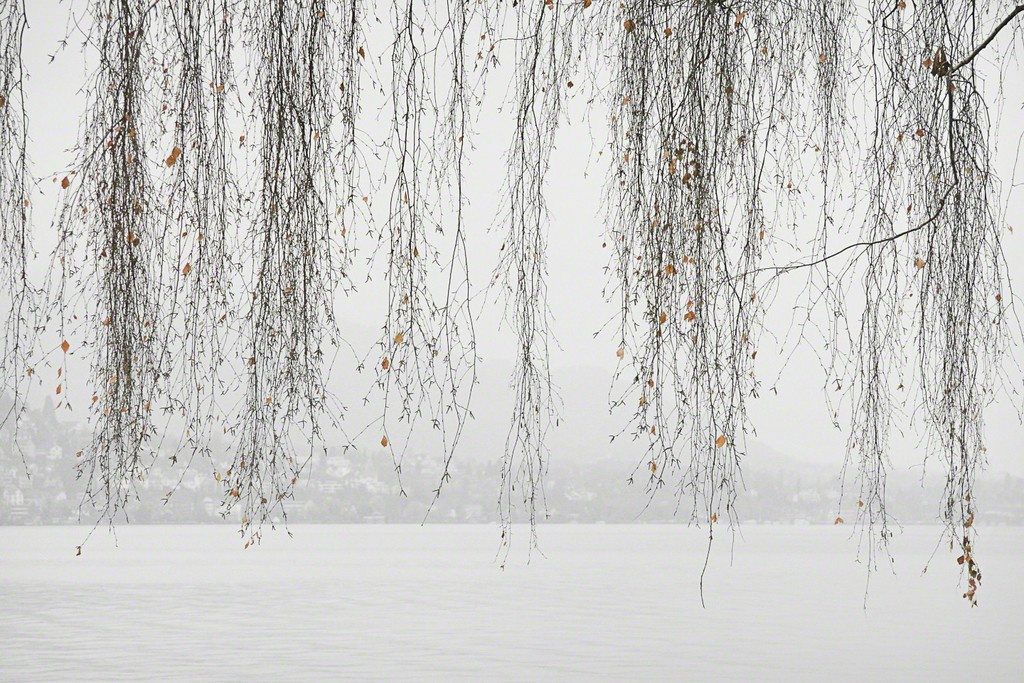
Lambrecht’s “Lake Trees No. 02” is like a ballet. We see two trees entwined in a dance. The tree in the background is standing tall and straight. We almost straighten ourselves up in response. The tree with reddish leaves in the foreground seems to bow in acknowledgement to the other. The tree in the background has no leaves, while in the foreground the lower tree’s long, convoluted branches have a touch of red leaves. It feels like fall. There is a silence in the image. It perhaps is not quite winter. But there is a silence. The visual quiet allows a reflection. Unlike “Lake Trees No. 16” in which we peer off to the distant shore, in “Lake Trees No. 02” we stay entangled in the branches of these trees. The tall birch bark-like tree with its willow-like branches, is a back stop and our eyes need not go further. The red-leafed tree however holds our eyes firmly and comfortably in the foreground. This is Lambrecht’s secret to her compositions. She grabs our stare, holds onto it, and we hypnotically study her images.

Vladimir Frumin, in his images, captures the duel between man and nature. His trees have very different expressions. Rather than a colorful companionship for us in nature, they exhibit an isolation. More than just trees barren in winter, these trees are objects of desolation. The “Tree in Fog” is as close as Frumin will get to allowing us a relationship with nature on even terms. It is a beautifully gentle image, yet has an air of mystery. It is as if we can approach this tree, but we stand at a distance for fear of being swallowed up by the fog and gradually advancing darkness that seems to be absorbing this tree, taking it away from us. While there is not a physical barrier, the atmospheric conditions impose one. Yet, we are drawn into it. Not with gaiety, color and light – but foreboding. The soft visual here may remind us of the black and white imagery of British photographer Michael Kenna’s landscapes. His tree images in black and white, with his signature soft tone and gradations of grays and blacks, have a subtle consistency. Frumin’s images, on the other hand, go from the soft gentle tones in “Tree in Fog” to the stark, defined, “Shoe tree” image with a loudly spoken visual social commentary. Frumin’s images are rich in commentary about humankind, society and nature. Not always with positive expression, but more thoughtful and forceful expression, to engage and challenge the viewer.
 Image by Vladimir Frumin © 2016 “Tree in Fog 0322”
Image by Vladimir Frumin © 2016 “Tree in Fog 0322”
In the “Tree with Ladder” Frumin takes this anxiety further by daring us, the viewer, to climb up into the tree. Many childhoods are filled with appealing memories of tree climbing. This tree has almost a “Twilight Zone” quality. If we climb that ladder into the tree, as the image invites us to do, we fall into a different dimension where this tree resides, that is as desolate as a lunar landscape. Worse, it may be reminiscent of a medieval painting of hell.
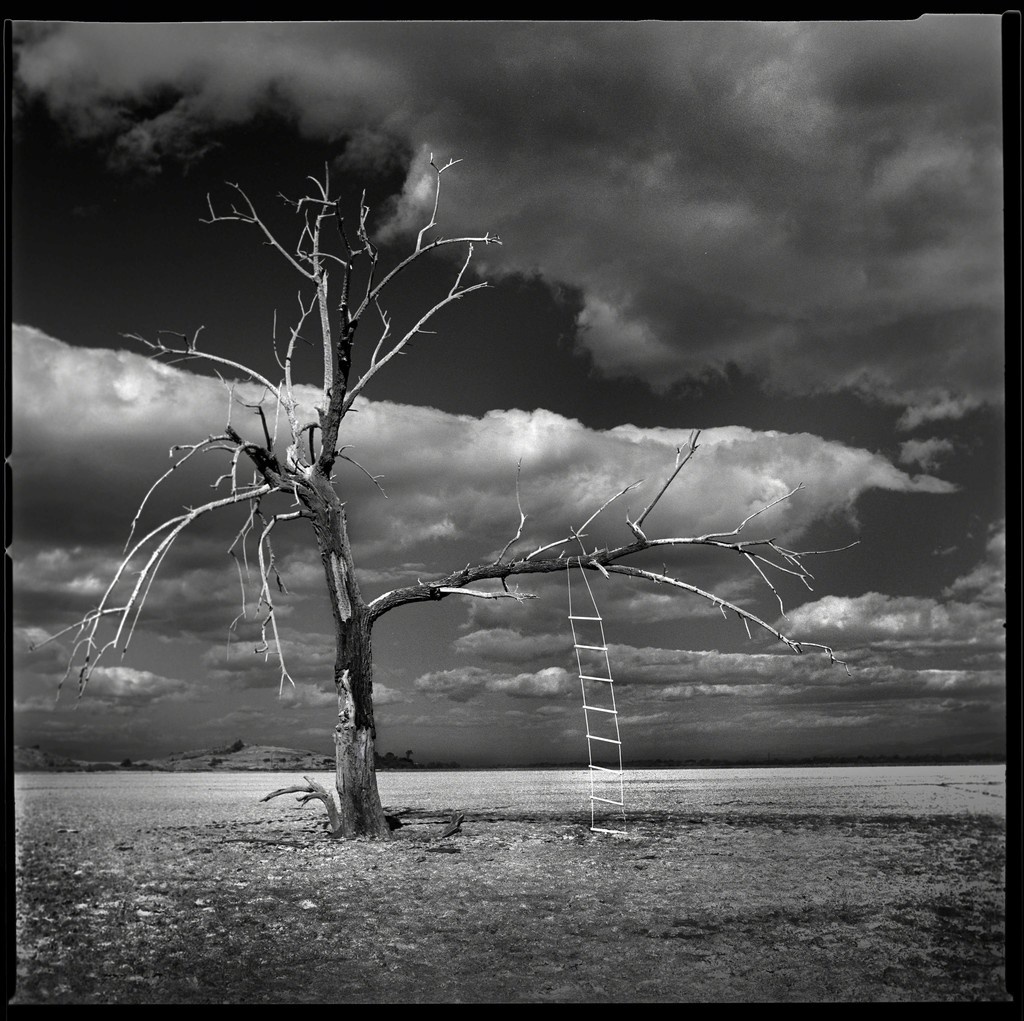
With Frumin’s work, the tree is an actor in performance on a stage. The stage in Frumin’s images is the uninviting landscape. Strangely, the viewer will feel invited into this desolate scene. Like an actor cleverly costumed, his trees seem dressed to perform. He infuses his tree images with a magical attraction. Other photographers use trees as an expression of nature itself or as a pleasant companion in the image. Frumin’s images express a frustration with humankind and its relationship to our natural environment.
His image “Shoe Tree” reminds us that we have created our own hell on earth. It is a visual expression of our burden weighing down nature. In essence, how we have walked all over nature. The land all around the tree is barren. In the distance, we see scrub-like hostile bushes. It almost seems like some creature is hiding in these bushes to pounce on us if we move too close. It is as if the shoes were thrown up into the tree as a talisman to ward off the evil spirit beyond our view.
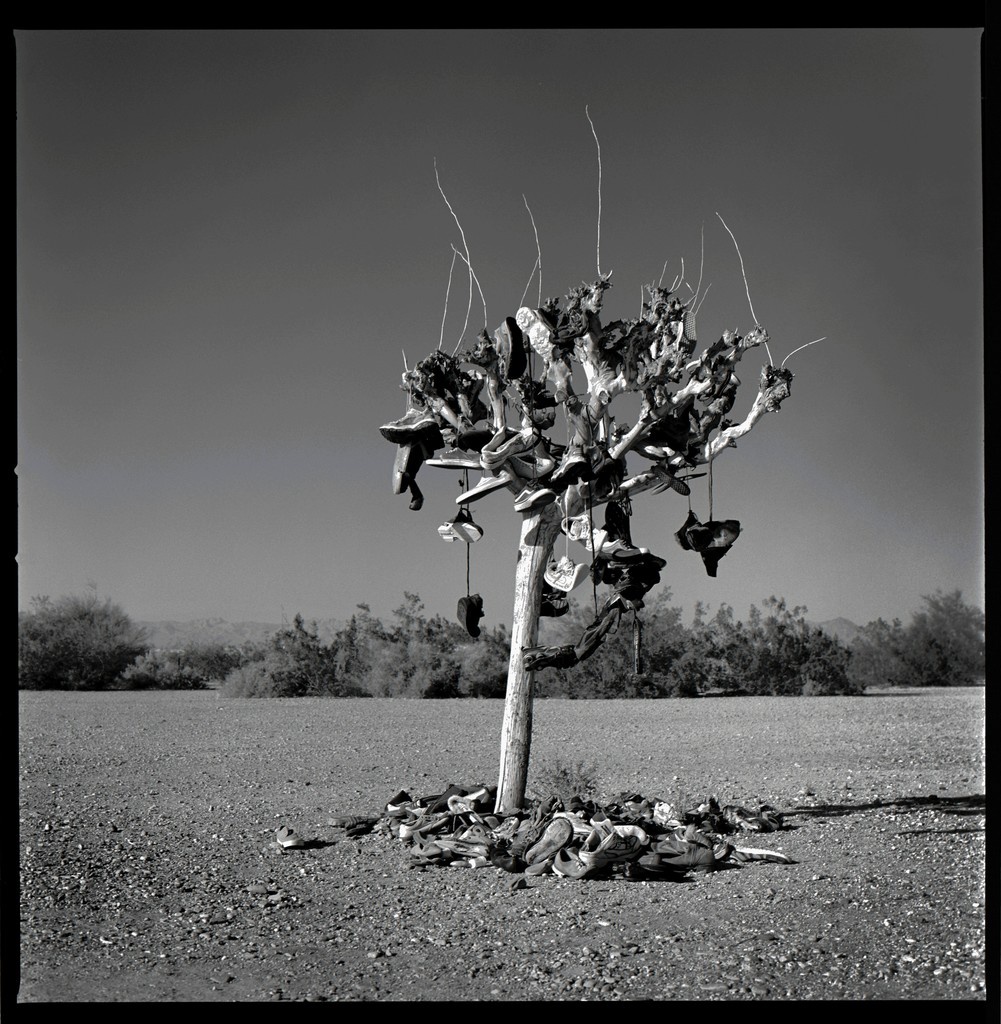
Notice that in each of his images, a different mood is set. In the first, there is a warm comforting fog. We feel at ease and complacent. In the second, the ladder and tree are set against a cloudy sky. The clouds do not look hostile and they set a playful mood. It is inviting us to climb a flimsy rope ladder up into a barren leafless tree. It is a trap. While trees might remind us of a joyful childhood of climbing ropes, swings and tree houses in leafy cool and colorful trees, this tree is anything but that. It is barren and desolate. What enjoyment can we gain in climbing up onto the branches of this tree? Frumin creates a hypnotic visual deception. We can not take our eyes off the ladder and the swing, and against our better judgement, we will climb up. It reminds us that we do things we should not do, even when we know better. In the third, the tree is full of shoes, the backdrop is a perfectly clear sky. Lots of light. The air looks clean and fresh. This allows his image to ambush and ensnare the viewer. We get caught up looking closely at the interesting detail in the image and become stalled in anxiety.
Each of these artists teaches us that we see nature, and trees in particular, through different eyes. Each uses the lens of the camera with a different focus, both literally and figuratively. With something as ubiquitous as a tree, these photographers provide lessons in how and what to see and look at. The texture of bark. Leafless branches against a gray sky. Looking at a tree, alone and isolated or in a forest in which we are challenged to search and distinguish. The use of light exposes and highlights the leaves, the trunk and branches. The contrast of white winter snow is stark against the darkness of bark. The visual intrigue of gnarled roots or the majesty of a redwood or sequoia. The teach us to look at barren fields or pastures full of bright flowers in a foreground or mountains in a background, or the drama of strong storm clouds that envelope distant surroundings. We find a fence or sentinel-like images of trees by rivers. We find ourselves wanting to study trees reflected in water, or the creative shadows cast on a sunny day. There is the color of fruit in trees that enriches photographs. Then again, there are the endless variety of images with the colors of leaves in fall, or the vibrant greens of spring. There are also disturbing tree images. We see trees in urban settings, alone, surrounded by concrete. Trees set against a cityscape, or surrounded by junk. But not all images in an urban setting are troubling. There is the ubiquitous decorated Christmas tree.
With a never ending number of photographs of trees, what makes the work of these photographers special? Michael Kenna said: “Photography, for me, is not about copying the world. I’m not really interested in making an accurate copy of what I see out there. I think one of photography’s strongest elements is its ability to record a part of the world, but also to integrate with the individual photographer’s aesthetic sense. The combined result is an interpretation – and the interpretation, I think, is what is interesting – when the subject goes through the filter of an individual human mind and emerges in a changed state – not the duplication or the recording of something”. (5) These three photographers, David Reinfeld, Laurie Lambrecht and Vladimir Frumin filter what they see with their own vision. Each creates wonderfully unique and engaging images in their own voice.
Notes:
- “Tree: A New Vision of the American Forest”, by James Balog, Barnes & Noble Books (2004).
- Ibid, Tree, from James Balog’s own Introduction to his book.
- “The Tree in Photographs”, Françoise Reynaud, Getty Publications, The J. Paul Getty Museum, Los Angeles (2011).
- All quotes from David Reinfeld are from an interview with the Geoffrey Koslov of Foto Relevance.
- From the introductory essay “Inventing Peace” by Anne W. Tucker, quoting Michael Kenna in an interview with Brooks Jensen, Lens Work, No. 50. December 2003-January 2004, in Michael Kenna: Retrospective Two, Nazraeli Press (2004). The interview can be found at : http://www.michaelkenna.net/ivlens.php
